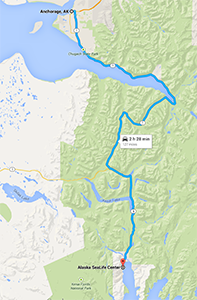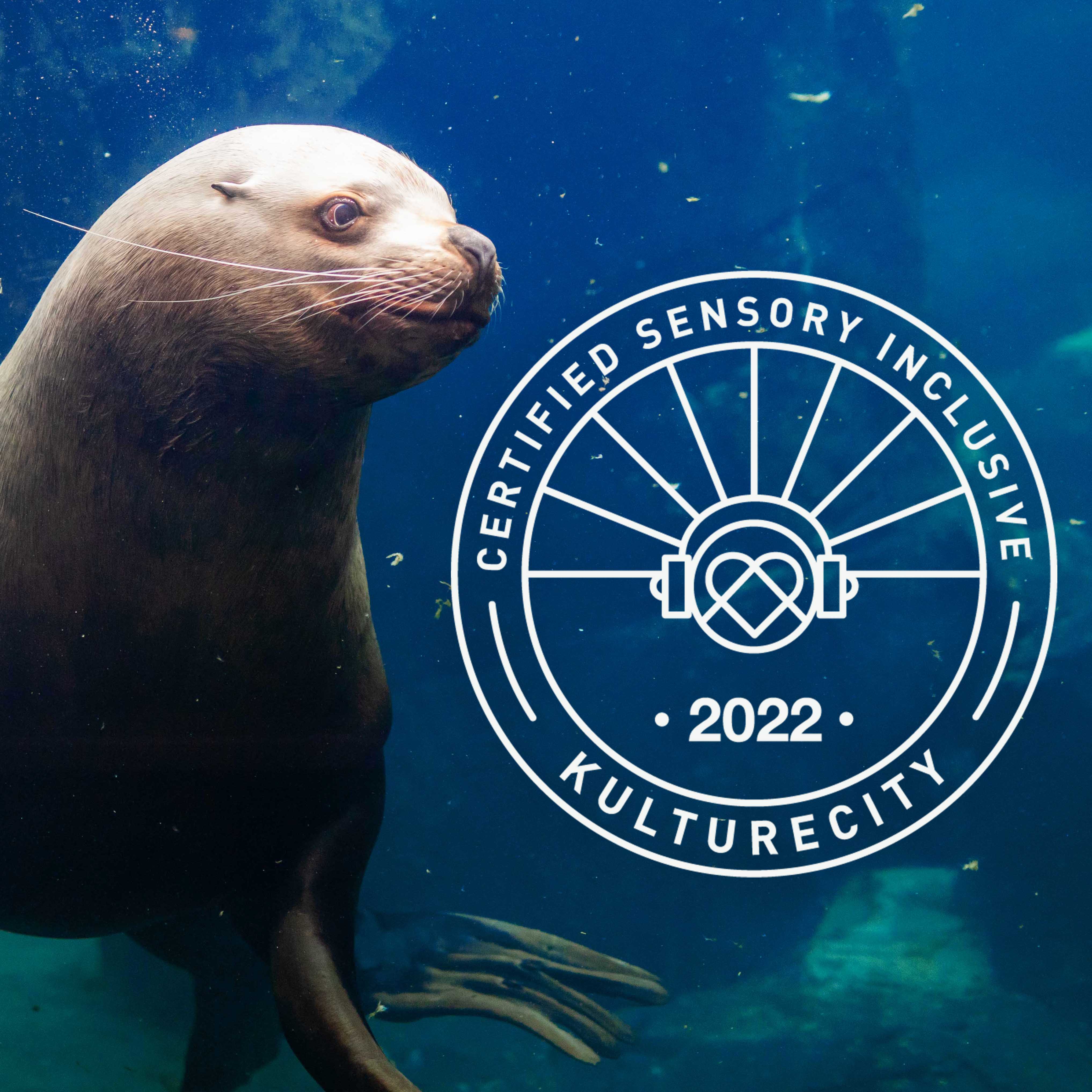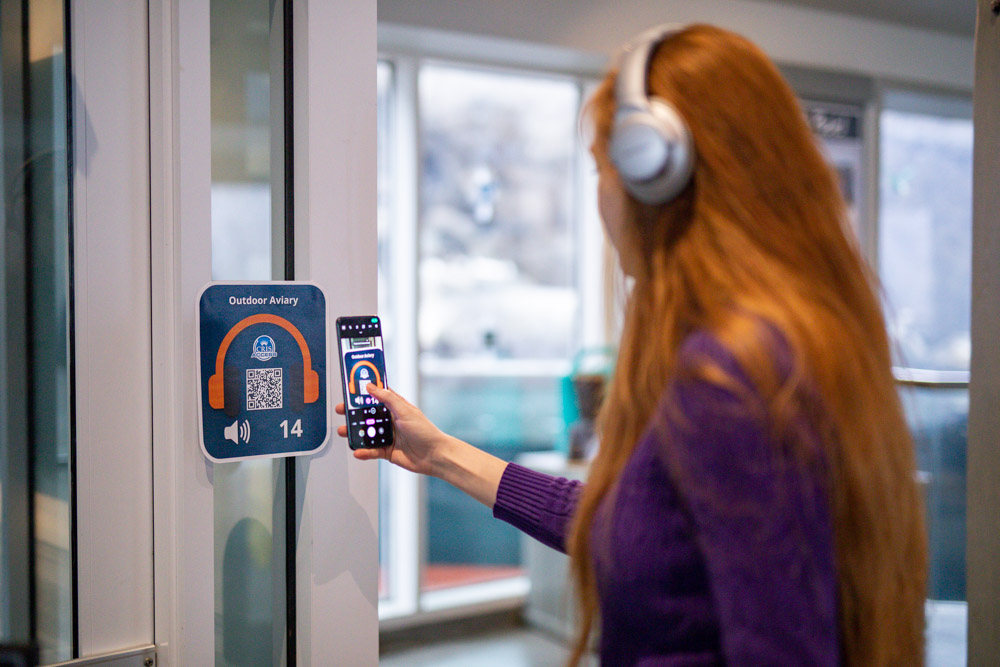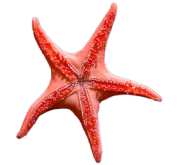Directions & Accessibility
The Alaska SeaLife Center is located at Mile 0 of the Seward Highway in Seward, Alaska, 125 miles south of Anchorage. You can reach Seward by road year-round, or via the Alaska Railroad or cruise ship during the summer season.
Getting Here
Car or RV:
The highway to Seward is one of the most scenic byways in Alaska. We are located approximately 125 miles south of Anchorage at Mile 0 of the Seward Highway. For the most up-to-date safety, traffic, and travel information on Alaska's highways, visit Alaska 511 online.

Cruise Ship:
Some cruise lines provide transfer service from the dock to the Alaska SeaLife Center as part of your tour. If you wish to visit us independently, we recommend using the shuttle or taxi services detailed below.
Transportation from Anchorage:
Transportation between Anchorage and Seward is available daily during the summer season through the Park Connection. Year-round transportation is available through Seward Bus Line.
Local Shuttles & Taxis:
There is a free shuttle offered by the Seward Chamber of Commerce during the summer season that has stops at the rail and cruise terminals.
There are also several taxi services in Seward.
- Glacier Taxi: 907- 224-5678
- Mike’s Taxi: 907- 224-2244
- PJ’s Taxi: 907- 224-5555
- Seward Taxi & Tours: 907- 362-8000
Parking
Parking is available at no charge year-round. Our parking lot is located adjacent to the Center.
Accessibility
The Alaska SeaLife Center welcomes guests of all abilities. Please contact our visitor services team if you have any questions about available accommodations and accessibility at visit@alaskasealife.org.
The Alaska SeaLife Center is wheelchair & stroller accessible. We do have a small number of wheelchairs and strollers available for use during your visit.
Service Animals
In compliance with the American Disabilities Act, and Association of Zoos and Aquariums accreditation standards, the Alaska SeaLife Center accommodates service animals (dogs and miniature horses) in all public areas with the exception of areas where there is concern that the service animal could affect the safety and health of collection animals, specifically the open-air aviary; and with the following understandings:
• Service animals must be trained to perform specific or task directly related to a person’s disability.
• Companion animals, therapy animals and comfort animals are not service animals.
• Service animals must be under control and harnessed, leashed, tethered, under voice, signal or other effective control.
Staff at the ASLC may ask you two questions:
1. Is the animal required because of a disability?
2. What work or task has the animal been trained to perform?
The ASLC retains the right to request that service animals be removed from the premises if 1) the animal is out of control and the handler does not take control, 2) the animal is not housebroken, or 3) the animal’s behavior poses a direct threat to the safety of others.
Some ASLC tours include areas that are not open to service animals. ASLC security is available to briefly assist tour guests with service animals for that portion of the tour by staying with the animal in an adjacent unrestricted area.
ADA Guidelines
You can find information about ADA guidelines for service animals on the ADA website at https://www.ada.gov/regs2010/service_animal_qa.html#exc. From the ADA “Frequently Asked Questions” site the following applies:
“Exclusion of Service Animal”
Q25. When can service animals be excluded?
A. The ADA does not require covered entities to modify policies, practices, or procedures if it would “fundamentally alter” the nature of the goods, services, programs, or activities provided to the public. Nor does it overrule legitimate safety requirements. If admitting service animals would fundamentally alter the nature of a service or program, service animals may be prohibited. In addition, if a particular service animal is out of control and the handler does not take effective action to control it, or if it is not housebroken, that animal may be excluded.
Q.26. When might a service dog’s presence fundamentally alter the nature of a service or program provided to the public?
A. In most settings, the presence of a service animal will not result in a fundamental alteration. However, there are some exceptions. For example, at a boarding school, service animals could be restricted from a specific area of a dormitory reserved specifically for students with allergies to dog dander. At a zoo, service animals can be restricted from areas where the animals on display are the natural prey or natural predators of dogs, where the presence of a dog would be disruptive, causing the displayed animals to behave aggressively or become agitated. They cannot be restricted from other areas of the zoo.
 Certified Sensory Inclusive by KultureCity
Certified Sensory Inclusive by KultureCity
The Alaska SeaLife Center was the first organization in the state of Alaska to be certified Sensory Inclusive by KultureCity. Our front-line staff have been trained and equipped with the knowledge to help people with sensory disabilities if needed during their visit.
Signage can be found throughout the aquarium designating where the quiet area and headphone zones are located.
Resources:
- View the ASLC social story to prepare for your visit and have the best experience possible.
- View the Headphone Zone Map to prepare for potentially loud areas
- Sensory Bags, provided by KultureCity, can be checked out from the admissions counter free of charge and include headphones, the ASLC headphone zone map, fidgets, verbal cue cards, and a VIP lanyard. We also have a weighted lap pad that is available on request.
Audio Tour
 The ASLC Audio Tour offers rich descriptions to support visitors who are blind or have low vision, providing access to information that may not be available through visual exhibits and signage. It features some unique stories and perspectives not presented in written displays. Some stories by Sugpiaq Native Elders are presented with permission through an ongoing partnership with Chugachmiut Heritage Preservation, a program of Chugachmiut, the tribal consortium dedicated to promoting the self-determination of the seven Alaska Native communities in the Chugach Region of South-Central Alaska.
The ASLC Audio Tour offers rich descriptions to support visitors who are blind or have low vision, providing access to information that may not be available through visual exhibits and signage. It features some unique stories and perspectives not presented in written displays. Some stories by Sugpiaq Native Elders are presented with permission through an ongoing partnership with Chugachmiut Heritage Preservation, a program of Chugachmiut, the tribal consortium dedicated to promoting the self-determination of the seven Alaska Native communities in the Chugach Region of South-Central Alaska.
For the enjoyment of all guests, we ask that you use headphones or earbuds when accessing the audio tour.
This audio program and accompanying booklet were made possible through generous grants from the U.S. Department of Education’s Governor’s Emergency Education Relief Funds through the office of Alaska Governor Mike Dunleavy with additional support from the Seward Community Foundation, recorded in partnership with Chugachmiut Heritage Preservation, a program of Chugachmiut, the Tribal consortium created to promote self-determination to the seven Native communities of the Chugach Region, and CRIS Radio, a nonprofit 501(c)3 radio-reading service, serving people who are blind or print-challenged.


